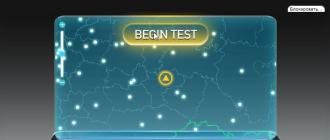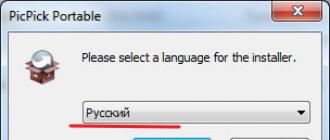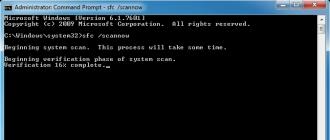Briefly about MIMO.
Technology based on the IEEE 802.11n WiFi standard.
Wi - Life represents short review WiFi technologyIEEE 802.11 n .
Extended information to our video publications.
First WiFi 802.11n generation
appeared on the market a few years ago. MIMO Technology (MIMO - multiple input / multiple output - multiple inputs / multiple outputs) is the core of 802.11n. This is a radio system with many separate transmission and reception paths. MIMO systems are described using a number of transmitters and receivers. WiFi 802.11n standard defines a set of possible combinations from 1x4 to 4x4.
In a typical case of deploying a Wi-Fi standard network indoors, for example in an office, workshop, hangar, hospital, the radio signal rarely goes along the shortest path between the transmitter and receiver due to walls, doors and other obstacles. Most of these environments have many different surfaces that reflect a radio signal (electromagnetic wave) like a mirror that reflects light. After re-reflection, multiple copies of the original wiFi signal. When multiple copies of the WiFi signal travel in different ways from the transmitter to the receiver, the shortest path will be the first, and the next copies (or the reflected echo of the signal) will come a bit later due to longer paths. This is called multipath signal propagation (multipath). Multiple distribution conditions are constantly changing because Wi-Fi devices often move (a smartphone with Wi-Fi in the user's hands), move around various objects creating interference (people, cars, etc.). If signals arrive at different times and at different angles, this can cause distortion and possible signal attenuation.
It is important to remember that WiFi 802.11 n support with MIMO and a large number of receivers can reduce the effect of multipath propagation and destructive interference, but in any case it is better to reduce the multipath propagation conditions where and as soon as possible. One of the most important points is to keep the antennas as far away from metal objects (first of all, omni wiFi antennasthat have a circular or omnidirectional radiation pattern).
Necessary clearly understand that not all Wi-Fi clients and WiFi Access Points are the same in terms of MIMO.
There are 1x1, 2x1, 3x3 clients, etc. For example, mobile devices like the smartphone most often support MIMO 1x 1, sometimes 1x 2. This is due to two key problems:
1. the need to ensure low energy consumption and long battery life,
2. the complexity in the arrangement of several antennas with adequate diversity in a small case.
The same goes for other mobile devices: tablet computers, PDA, etc ..
High-end laptops quite often now support MIMO up to 3x3 ( Macbook pro etc).

let's consider the main types MIMO on WiFi networks.
Now we will omit detailing the number of transmitters and receivers. It is important to understand the principle.
First type: Receive diversity on a WiFi device
If there are at least two connected receivers with diversity antennas at the receiving point,
it’s quite possible to analyze all the copies on each receiver to select the best signals.
Further, with these signals, various manipulations can be carried out, but we are primarily interested in
the possibility of combining them using MRC technology (Maximum Ratio Combined). MRC technology will be discussed in more detail below.
Second type: Diversity when sending a signal to a WiFi device
If at the sending point there are at least two connected WiFi transmitters with spaced antennas, then it becomes possible to send a group of identical signals to increase the number of copies of information, increase the reliability of transmission and reduce the need to send data in the radio channel in case of loss.
Third type: Spatial signal multiplexing on a WiFi device
(combining signals)
If there are at least two connected WiFi transmitters with spaced antennas at the sending and receiving points, then it becomes possible to send a set of different information on top of different signals in order to create the possibility of a virtual combination of such information streams into one data channel, the total throughput of which tends to the sum of the individual flows of which it consists. This is called Spatial Multiplexing. But here it is extremely important to ensure the possibility of high-quality separation of all source signals, which requires a large valueSNR - signal to noise ratio.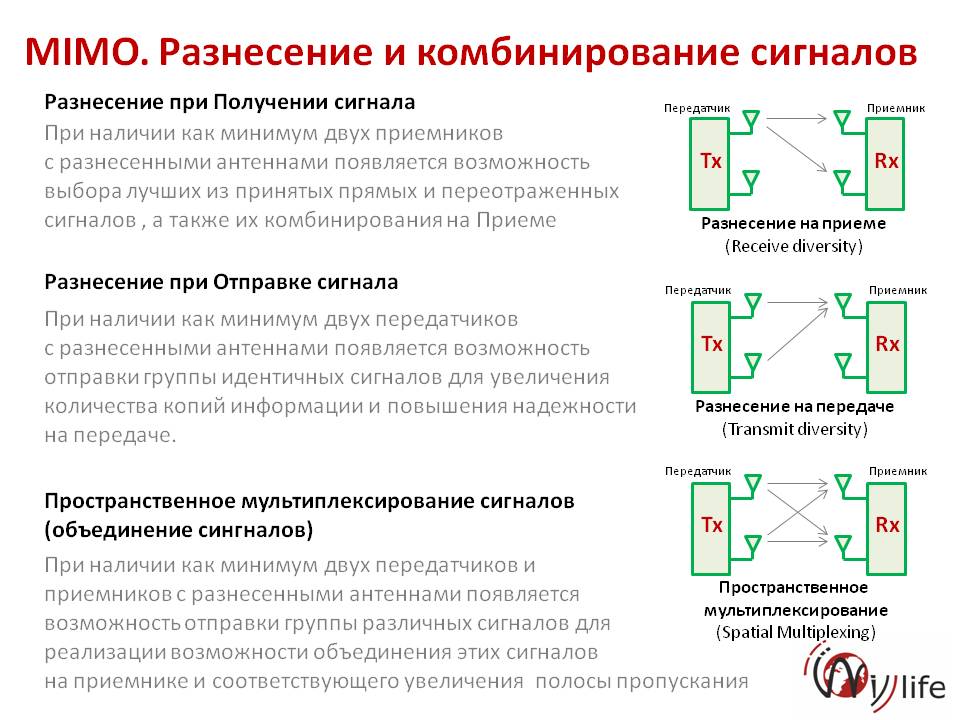
MRC technology
(maximum ratio combined ) is used in many modern Access PointsWifi enterprise class.
Mrc aimed at raising the signal level in the direction fromWifi Client to WiFi 802.11 Access Point.
Work algorithmMrc involves the collection on several antennas and receivers of all direct and re-reflected signals during multipath propagation of signals. Further special processor (DSP ) selects best signal from each receiver and performs the combination. In fact, the mathematical processing implements a virtual phase shift to create positive interference with the addition of signals. Thus, the resulting total signal is much better in characteristics than all the original ones.
Mrc allows you to provide significantly better working conditions of low-power mobile devices in a standard networkWifi . 
On WiFi 802.11n Systems
The advantages of multipath propagation are used for the simultaneous transmission of several radio signals. Each of these signals, called " spatial streams», Sent from a separate antenna using a separate transmitter. Due to the presence of a certain distance between the antennas, each signal follows a slightly different path to the receiver. This effect is called " spatial diversity". The receiver is also equipped with several antennas with their own separate radio modules, which independently decode the incoming signals, and each signal is combined with signals from other receiving radio modules. As a result of this, several data streams are received simultaneously. This provides significantly higher bandwidth than previous WiFi 802.11 systems, but also requires a client with 802.11n support.
Now a little deeper into this topic:
On WiFi devices withMimo it is possible to divide the entire incoming information stream into several different data streams using spatial multiplexing for their subsequent sending. Multiple transmitters and antennas are used to send different streams in one frequency channel. You can visualize this in such a way that some text phrase can be transmitted so that the first word is sent through one transmitter, the second through another transmitter, etc.
Naturally, the receiving side must support the same functionality (MIMO) for the full selection of various signals, their reassembly and association using, again, spatial multiplexing. So we get the opportunity to restore the original information flow. The presented technology allows you to divide a large data stream into a set of smaller streams and transmit them separately from one another. In general, this makes it possible to more efficiently utilize the radio environment and specifically the frequencies allocated for Wi-Fi. 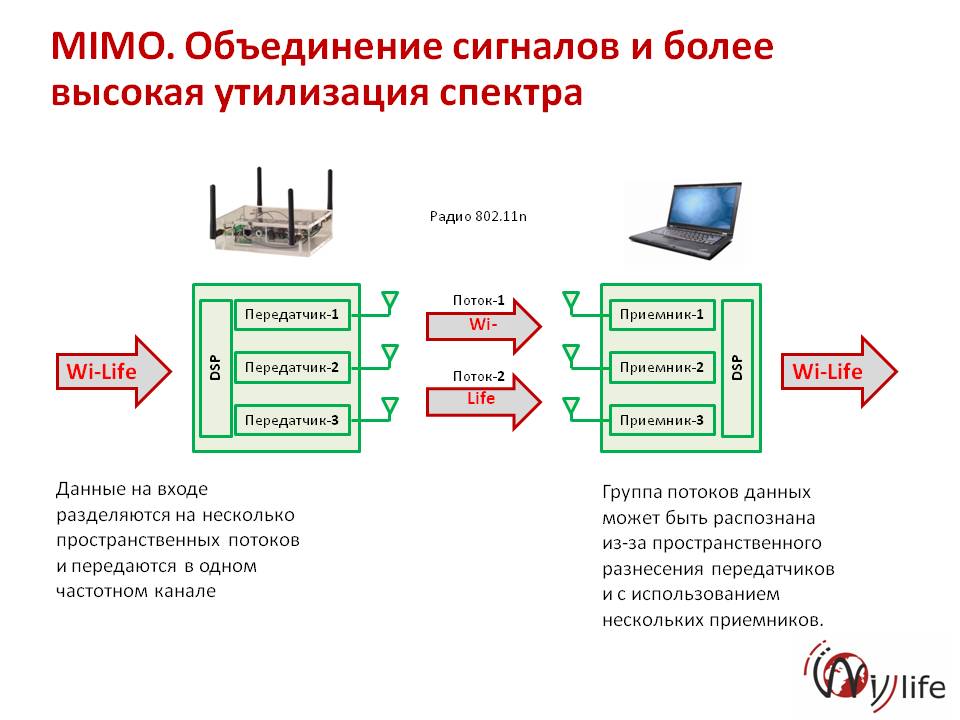
WiFi 802.11n technology
It also determines how MIMO can be used to improve the SNR level at the receiver using transmit beamforming control. With this technique, it is possible to control the process of sending signals from each antenna so that the parameters of the received signal in the receiver are improved. In other words, in addition to sending multiple data streams, multiple transmitters can be used to achieve a higher SNR at the receiving point and, as a result, a higher data rate on the client.
The following things should be noted:
1. The procedure for controlling the beam pattern (transmit beamforming), defined in the Wi-Fi 802.11n standard, requires collaboration with the receiver (in fact, with the client device) to obtain feedback about the state of the signal at the receiver. Here you need to have support for this functionality on both sides of the channel - both on the transmitter and on the receiver.
2. Due to the complexity of this procedure, transmit beamforming control was not supported in the first generation of 802.11n chips, both on the terminal side and on the Access Point side. Currently, most existing chips for client devices Also Do not support this functionality.
3. There are solutions for building networksWifi , which allow you to fully control the radiation pattern on Access Points without the need for feedback from client devices.
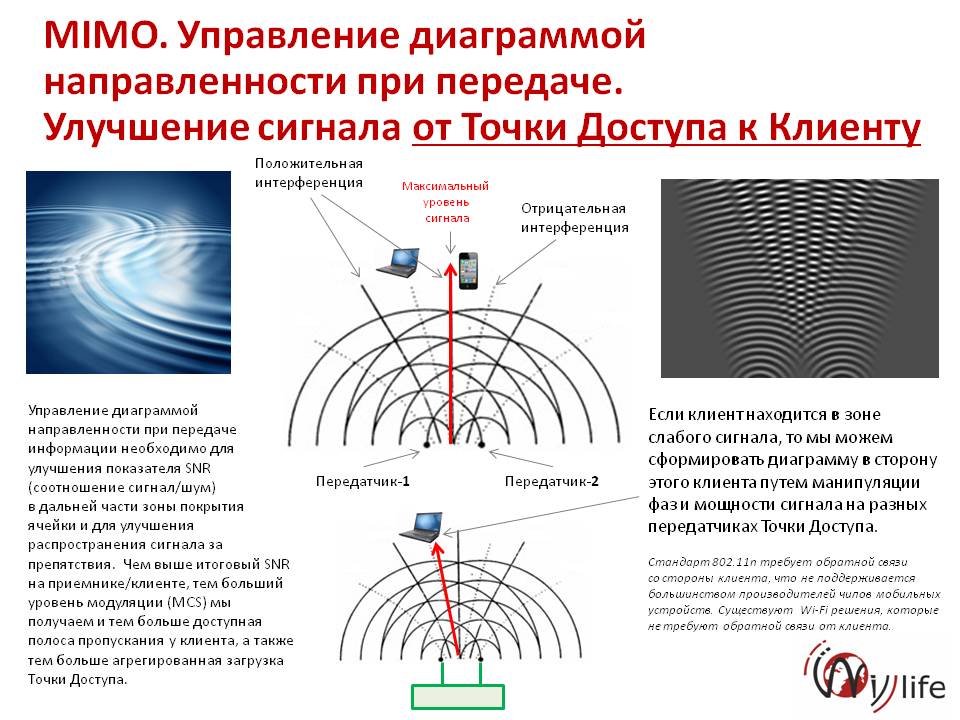
To receive announcements upon the release of new thematic articles or the appearance of new materials on the site, we offer.
Join our group on
The essence of MIMO technology and MIMO 2x2 antennas
Most of you have probably heard of such a thing as MIMO technology.
What is MIMO? This abbreviation stands for "Multiple Input Multiple Output", which in
translated means: "Multiple Entry Multiple Exit." The essence of the technology is as follows: the spatial bandwidth of the channel is increased by the method of spatial coding of the signal, in which data is transmitted through a number of antennas. In simple words: Signal expansion occurs due to an increase in the number of parallel antennas.
Most often, MIMO technology is used in Wi-Fi. Using this technology, the data transfer rate becomes more than 300 megabits per second. In addition, thanks to MIMO, the wireless network has become faster in transmitting information even where the signal reception level is minimal. As in Wi-Fi, in 4G the speed exceeded the threshold of 300 megabits per second.
The main advantage of MIMO is its excellent and stable connection, even at a decent distance from the station.
The essence of MIMO technology. In other words: by parallelizing the flow into several channels, you can start them in different ways through several antennas, and accept them as independent antennas at the reception. If we transmit the same information through two MIMO channels with a small delay, having encoded it previously, we can recover the lost symbols on the receiving side, which is equivalent to an improvement in the signal-to-noise ratio up to 10-12 dB. This technology leads to an increase in speed.
For channel separation, polarization is applied. IN wIFI networks MIMO technology works in the IEEE 802.11n and IEEE802.11ac standards and is already supported by many devices. In the topic related to MIMO there is such a term as cable assemblies. Cable assemblies - a cable that connects the antenna and the transmitting device (modem, router). For the right choice cable assembly, you need to know the distance from the antenna to the device. The assembly includes a cable and two connectors.
There is also such a term as polarization. Polarization of the waves. Waves in which the directions of the electric and magnetic fields remain unchanged in space or change according to a certain law are called polarized.
Polarization is inclined, vertical and horizontal.
Distinguish between 3G and 4G antennas.
External antennas are used in the following cases:
The connection speed is lower than the operator said.
Unstable connection.
Weak signal or its complete absence.
Antennas are of several types: panel, stationary, circular, multi-standard, universal, directional, omnidirectional, sector and many others.
When choosing an antenna, you need to know such characteristics as:
Operating frequency range (MHz).
Gain.
Input impedance.
Active emitter antennas are reliably sheltered from rainfall in a plastic case protected from ultraviolet radiation. Antenna inputs are shorted to direct current between the external and internal conductors, which reduces the likelihood of static electricity accumulating at the modem input and makes the use of a lightning arrester optional (with a small length of the connecting feeder between the modem and antenna). Mount allows you to mount the antenna on a vertical pipe,
antenna angle adjustment is provided. Also, due to the mounting design, a smooth change in the slope of the polarization is possible.
2. The first universal remote antenna NITSA-5 MIMO 2x2 with support for LTE-A (up to 300 Mb / s). Also Nitsa-5 MIMO 2x2 is intended for use in the kit c cell phones, modems or repeaters of the LTE800 / GSM900 / GSM1800 / UMTS900 / UMTS2100 / WIFI2400 / LTE2600 standards. Active emitter antennas are sheltered in a plastic case. The mount allows you to change the angle of the antenna and the polarization tilt. Recommended for use at distances up to 10 km from the base station. Thanks to the support of MIMO technology, this antenna will be a universal solution for any high-speed standard.
3. Universal panel antenna 15-17 dBi (1.7-2.7 GHz)
The AGATA MIMO 2x2 BOX panel antenna with a sealed box for the USB 3G / 4G modem is a ready-made solution for amplifying a 2G / 3G / LTE signal. Type of antenna - common mode array. Recommended for use at the boundaries of service areas, with a weak and unstable signal level. Thanks to the use of a USB extension cable from an FTP CAT5 cable, it became possible to eliminate signal loss in the antenna-modem section.
This solution allows gaining up to 6 dB in signal amplification, which may be a decisive factor in improving communication.
On the fingers about MIMO.
Imagine that information is people, and modem and base station The operator is two cities between which one path is laid, and the antenna is the station. We will transport people by train, which, for example, can carry no more than a hundred people. The capacity between such cities will be limited, as the train can only take one hundred people at a time.
So that 200 people can arrive in another city at the same time, between the cities they build a second path and launch a second train at the same time as the first, thereby doubling the flow of people. MIMO technology also works in the same way, in fact we just double the number of threads. The number of streams is determined by the MIMO standard, two streams are MIMO 2x2, four streams are MIMO 4x4, etc. To transfer data over the Internet, whether it is 4G LTE or WiFi for today, as a rule, the MIMO 2x2 standard is used. To receive a dual stream at the same time, you will need two conventional antennas, or by analogy two stations, or, to save money, one MIMO antenna, as if it were one station with two platforms. That is, a MIMO antenna is two antennas inside one.
A panel MIMO antenna can literally have two sets of radiating elements ( patches) in one housing ( for example, four patches work in vertical polarization, the other four in horizontal, eight patches in total) Each set is connected to its own jack.
And it can have one set of patches but having two-port (orthogonal) power supply, so the antenna elements are powered with a phase shift of 90 degrees, and then each patch will work in vertical and horizontal polarization at the same time.
In this case, one set of patches will be connected immediately to two sockets, these are the MIMO antennas that are sold in our online store.
More details
Mobile broadcast of the digital stream LTE is directly related to the new 4G developments. Taking a 3G network for analysis, you can find that its data transfer speed is 11 times less than 4G. Nevertheless, the speed of both receiving and broadcasting LTE data is often of poor quality. This is due to the lack of power or signal strength that the 4G LTE modem receives from the station. To significantly improve the quality of dissemination of information, 4G MIMO antennas are introduced.
Modified antennas, compared to conventional data distribution systems, have a different transmitter circuit. For example, you need a digital stream divider to distribute information to low speed streams, the number of which is related to the number of antennas. If the speed of the incoming stream is approximately 200 megabits per second, then two streams will be created - both at 100 megabits per second. Each stream must be broadcast through a separate antenna. The polarization of the radio wave transmitted from each of the two antennas will be different in order to decrypt the data during reception. The receiver must also have two receiving antennas in different polarizations in order to maintain the data transfer rate.
Advantages of MIMO
MIMO is the distribution of several streams of information on just one channel at a time, and then passing them through a pair or more antennas before they reach the receiving independent devices for broadcasting radio waves. This can significantly improve signal throughput without resorting to bandwidth expansion.
When broadcasting radio waves, the digital stream in the radio channel selectively freezes. This can be seen if you are surrounded by urban high-rise buildings, moving at high speed or moving away from an area that radio waves can cover. To get rid of this problem, a MIMO antenna was created, capable of transmitting information on several channels with a slight delay. Information is precoded and then restored at the receiving side. As a result, not only increases the speed of data distribution, but also significantly improves signal quality.
According to their design features, LTE antennas are divided into ordinary and consisting of two transceiver devices (MIMO). A conventional signal propagation system can achieve speeds of no more than 50 megabits per second. MIMO gives you the chance to increase the speed of signal transmission more than twice. This is achieved due to the installation of several antennas in a box, which are located at a slight distance from one another.
Simultaneous reception, as well as distribution of the digital stream by the antennas to the receiver, occurs through two independent cables. This allows you to significantly increase the speed parameters. MIMO is used successfully in such wireless systemsoh, like WiFi, as well as cellular networks and WiMAX. The use of this technology, which, as a rule, has two inputs and two outputs, can improve the spectral quality of WiFi, WiMAX, 4G / LTE and other systems, increase the transmission speed of information and the capacity of the data stream. These advantages are achievable due to the transmission of data from a 4G MIMO antenna to the receiver through several wireless connections. Hence the name of this technology is taken (Multiple Input Multiple Output - multiple input and multiple output).
. Where MIMO is applied
MIMO quickly gained popularity by increasing the capacity and throughput of data transfer protocols such as WiFi. You can take the WiFi 802.11n standard as the most popular use case for MIMO. Thanks to MIMO communication technology, this WiFi protocol can reach speeds of more than 300 megabits per second.
In addition to speeding up the flow of information, the wireless network thanks to MIMO has received improved characteristics in terms of data transfer quality even in places where the level of the receiving signal is quite low. WiMAX thanks new technology got the opportunity to broadcast data at a speed of up to 40 megabits per second.
The 4G (LTE) standard allows the use of MIMO with configurations up to 8x8. Theoretically, this will allow the digital stream to be transmitted from the main station to the recipient at a speed of more than 300 megabits per second. Another attractive point from the application new system is a high-quality and stable compound, observed even at the border of the cell.
This means that even at a significant distance from the station, as well as when located in a room with thick walls, only a slight decrease in speed characteristics will be noticed. MIMO can be used in almost every wireless communication system. It should be noted that the potential of this system is inexhaustible.
They are tirelessly looking for ways to develop new configurations of MIMO antennas, for example, up to 64x64. In the near future, this will provide an opportunity to further improve the efficiency of spectral indicators, increase the capacity of networks and the speed of information transmission.
One approach to increasing the data transfer rate for WiFi standard 802.11 and WiMAX standard 802.16 is the use of wireless systems using multiple antennas for both the transmitter and the receiver. This approach is called MIMO (literal translation - “multiple input multiple output”), or “smart antenna systems” (smart antenna systems). MIMO technology plays an important role in the implementation of WiFi standard 802.11n.
In MIMO technology, several antennas of various kinds are used that are configured on the same channel. Each antenna transmits a signal with different spatial characteristics. Thus, MIMO technology uses the spectrum of radio waves more efficiently and without compromising operational reliability. Each wi-fi receiver “listens” to all the signals from each wifi transmitter, which allows you to make the data transfer paths more diverse. Thus, several paths can be recombined, which will lead to the amplification of the required signals in wireless networks.
Another plus of MIMO technology is that this technology provides Spatial Division Multiplexing (SDM). SDM spatially compresses several independent data streams simultaneously (mainly virtual channels) within the same spectral channel bandwidth. In fact, several antennas transmit various data streams with individual coding of signals (spatial streams). These flows, moving parallel through the air, “shove” more data along a given channel. At the receiver, each antenna sees different combinations of signal streams and the receiver “demultiplexes” these streams for their use. MIMO SDM can significantly increase data throughput by increasing the number of spatial data streams. Each spatial stream needs its own transmit / receive (TX / RX) antenna pairs at each end of the transmission. The operation of the system is shown in Fig. 1
It must also be understood that the implementation of MIMO technology requires a separate radio frequency circuit and an analog-to-digital converter (ADC) for each antenna. Implementations requiring more than two antennas in a circuit must be carefully designed so as not to increase costs while maintaining the proper level of efficiency.
An important tool for increasing the physical speed of data transmission in wireless networks is the expansion of the bandwidth of spectral channels. By using a wider channel bandwidth with orthogonal frequency division multiplexing (OFDM), data is transmitted with maximum performance. OFDM is a digital modulation that has proven itself as a tool for implementing bidirectional high-speed wireless transmission data in WiMAX / WiFi networks. The method of expanding channel capacity is cost-effective and fairly easy to implement with moderate growth digital processing Signal (DSP). When used correctly, you can double the bandwidth of the Wi-Fi 802.11 standard from a 20 MHz channel to 40 MHz, and you can also provide more than double the bandwidth of the channels currently used. By combining the MIMO architecture with a wider channel bandwidth, a very powerful and cost-effective approach is obtained to increase the physical transmission speed.
Using MIMO technology with 20 MHz channels is expensive to meet IEEE requirements for WiFi 802.11n (100 Mbps bandwidth on MAC SAP). Also, to meet these requirements when using a 20 MHz channel, at least three antennas will be needed, both at the transmitter and at the receiver. But at the same time, working on the 20 MHz channel ensures reliable operation with applications that require high bandwidth in a real user environment.
The combined use of MIMO technology and channel expansion meets all the requirements of the user and is a fairly reliable tandem. This is also true when using multiple resource-intensive network applications. The combination of MIMO and 40 MHz channel expansion will meet even more complex requirements, such as Moore's Law and the implementation of CMOS technology to improve DSP technology.
When using the extended 40 MHz channel in the 2.4 GHz band, initially there were difficulties with compatibility with equipment based on WiFi standards 802.11a / b / g, as well as equipment using Bluetooth technology for data transfer.
To solve this problem in Wi-Fi standard 802.11n provides a number of solutions. One such mechanism, specifically designed to protect networks, is the so-called low throughput (non-HT) duplicated mode. Before Using Transfer Protocol wiFi data 802.11n standard, this mechanism sends one packet to each of the halves of the 40 MHz channel to declare a vector distribution network (NAV). Following the non-HT duplicated NAV mode of the message, the 802.11n data transfer protocol can be used during the time stated in the message, without violating the network legacy (integrity).
Another mechanism is a kind of alarm and does not allow wireless networks to expand the channel over 40 MHz. For example, the laptop has 802.11n and Bluetooth modules installed. this mechanism knows about the possibility of potential interference with the operation of these two modules at the same time and disables the transmission on the 40 MHz channel of one of the modules.
These mechanisms ensure that WiFi 802.11n will work with networks of earlier 802.11 standards without the need to switch the entire network to 802.11n equipment.
You can see an example of using the MIMO system in Fig. 2

If after reading any questions you have, you can ask them through the message sending form in the section
WiFi is a trademark for wireless networks based on the IEEE 802.11 standard. In everyday life, wireless users use the term " wiFi technology", meaning not the trademark, but the IEEE 802.11 standard.
WiFi technology allows you to deploy a network without laying a cable, thereby reducing the cost of network deployment. Thanks to WiFi, places where it is impossible to lay the cable, for example, outdoors and in buildings of historical value, can be served by wireless networks.
Contrary to popular belief about the “harmfulness” of WiFi, radiation from WiFi devices at the time of data transfer is two orders of magnitude (100 times) less than that of a cell phone.
MIMO - (eng. Multiple Input Multiple Output) - data transmission technology based on the use of spatial multiplexing for the simultaneous transmission of several information streams on one channel, as well as multipath reflection, which ensures the delivery of each bit of information to the corresponding recipient with a small probability of interference and data loss.
The solution to the problem of increasing bandwidth
With the intensive development of some high technologies, requirements for others increase. This principle directly affects communication systems. One of the most pressing issues in modern systems communication - the need to increase bandwidth and data transfer speed. There are two traditional ways of increasing throughput, expanding the frequency band and increasing the radiated power.
But due to the requirements for biological and electromagnetic compatibility, restrictions are placed on increasing the radiated power and expanding the frequency band. With such limitations, the problem of lack of bandwidth and data transfer speed makes us look for new effective methods for solving it. One of the most effective methods is the use of adaptive antenna arrays with weakly correlated antenna elements. MIMO technology is based on this principle. Communication systems that use this technology are called MIMO systems (Multiple Input Multiple Output).
802.11n and MIMO standard
This technology has found application in the IEEE 802.11n standard ( latest version 802.11 standard for wiFi networks), mobile WiMAX and LTE. The 802.11n standard increases the data transfer rate almost fourfold compared to 802.11g devices ( maximum speed which is 54 Mbps), provided that it is used in 802.11n mode with other 802.11n devices. Theoretically, 802.11n is capable of providing data transfer rates of up to 480 Mbps (In practice, the performance is of course lower). The 802.11n specification provides for the use of both standard channels with a width of 20 MHz, and broadband - at 40 MHz with higher bandwidth. A key component of the 802.11n standard called MIMO (Multiple Input, Multiple Output - many inputs, many outputs) involves the use of spatial multiplexing for the simultaneous transmission of several information streams on one channel, as well as multipath reflection, which ensures the delivery of each bit of information to the corresponding recipient with low probability of interference and data loss. It is the ability to simultaneously transmit and receive data that determines the high bandwidth of 802.11n devices.
Problems using MIMO WIFI
When building wireless network with the use of MIMO technology, telecom operators face the problem of the availability of affordable client devices that allow full use this technology. As a rule, when building such a network, equipment from one manufacturer is used. For example, good option the following set based on the proprietary AirMAX protocol can serve:
ubiquiti Rocket M5 Base Station
client ubiquiti device NanoStation M5
Food external points Access is via Ethernet. The current 802.3af (PoE) power supply standard does not provide the power needed to power access points with antenna configurations of 3 × 3 or higher. It is being replaced by the standard 802.3at, but until it is adopted, manufacturers wireless devices find workarounds for solving this problem (for example, due to auto shut off multipath), and wireless chip makers seek to reduce the power consumption of their chips. Along with global manufacturers, Ubiquiti is successfully coping with this task.
Just about complicated
MIMO technology is based on the following principles:
increasing the "width" of the channel (for example, from 20 MHz to 40 MHz in the WiFi 802.11n standard, see above for 802.11n)
to transmit information in one radio channel, several transmitters and several receivers are used. The number of transmitters and receivers may be different. The abbreviation MIMO, as a rule, is used, with numbers that indicate the number of transmitters and receivers. For example, MIMO 3 × 2, means that there are 3 transmitters and 2 receivers.
From practice. MIMO Applications with the AirMAX Example
One of the leaders in the implementation of MIMO technology is Ubiquiti Networks. Proof of this is the proprietary AirMAX protocol. The Ubiquiti room always offered “thought-out” wireless data transfer solutions, the qualitative differences of which were simplicity and ease of use, efficiency at a low price and reliability. Ubiquiti Networks currently offers a range of AirMAX equipment that requires increased data rates and affordable pricing for solutions. mIMO technology, which is also used in WiMAX. It’s nice to know that AirMAX solutions are many times and tens of times cheaper. The United Communications Technologies company presents a number of solutions for realizing tasks and AirMAX equipment.


